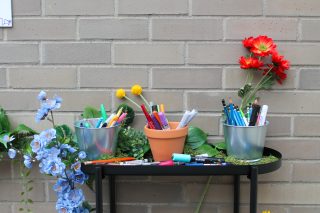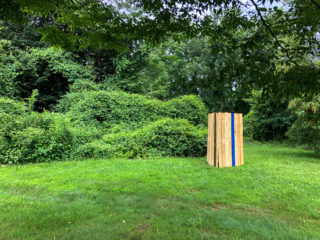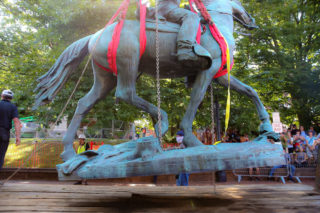
Despite its reputation as a liberal haven where most anything goes, San Francisco has notoriously strict anti-graffiti laws. Property owners are fined if they don’t remove graffiti within 30 days, and the City’s Public Works Department uses government funds to send out a regular Zero Graffiti Newsletter. The division between “graffiti” and “public art” in the City’s eyes is stark—unlike more progressive international cities, there seems to be no effort to understand graffiti and street art’s relationship to public art or its civic function in general. Banksy’s Haight Street Rat was famously only saved thanks to a man named Brian Greif, who made a deal with the building owner to preserve the piece for the public after the City threatened her with fines.
But San Francisco-based artist fnnch seems to have found a loophole, inventing a new form of street art in the process: sign bombing. In the interest of providing a “forum for communication among citizens,” Article 5.6 of San Francisco’s Public Works Code states that the public may post information on light and utility poles if they adhere to the following rules:
- Signs can only be installed on “Non-Commercial Streets” (less than 50% of the ground floor properties on a one block radius surrounding the pole can’t be storefronts or commercial enterprises).
- The signs have to be smaller than 11 inches in height, and no part of it can extend or be suspended beyond the face of the pole (for traffic safety purposes).
- No duplicate signs on a single pole.
- Signs can only be affixed to poles with tape or non-adhesive materials like string, twine or non-metal banding material.
- Signs must have the “posting date” printed legibly and visibly in the lower right-hand corner.
- And finally, signs must be removed within 70 calendar days of their posting.
fnnch followed all the rules above when he installed 450 of his signature honey bears as “signs” across downtown San Francisco last weekend, but it’ll be interesting to see how many of his bears actually make it the full 70 days. Aimed at pointing out all the inconsistencies in the City’s governance of public space, the bombing coincided with the artist’s release of a petition to the Board of Supervisors, asking for the decriminalization of stickers and wheatpaste. Online for less than a week, it’s already received over 12,000 signatures.

Lindsey Davis: In your Instagram post you write that sign bombing is technically legal under “certain conditions.” Do these “conditions” include your bears that went up yesterday, or is that what your petition is addressing?
fnnch: It was my intention for my bears to be fully in compliance with the law. Unfortunately the law is a little vague on certain points (notably what constitutes a “traffic control sign”) so I cannot be 100% sure, but I tried my best.
LD: Anyone walking down Caledonia, Balmy, or Lucky Streets could totally assume street art is legal in SF, or at least legal in those areas. Why do you think there’s such a gap between the unrelenting public creativity of SF’s artists and those who govern our public spaces?
fn: One of the main goals of my work is to bring art to the 95% of our citizens and visitors who do not go to our fine art museums. The plain truth is that most people do not have a personal relationship with visual art, and I see no reason why our government officials should be significantly different than the general public. And if they don’t have a personal relationship with it, then it makes sense why that gap exists.
LD: Why now? Is the wind changing for SF’s anti-graffiti laws?
fn: I don’t think there’s anything special about this particular moment. We are in the middle of a long transition in which artists are displaced by the rising cost of living and in which the city (and its citizens) seek to “clean up” the neighborhoods by policing and removing public forums of individual expression.
LD: What’ll happen once your petition gets the signatures it needs? Does the Board of Supervisors have to address it?
fn: Unfortunately this is not like a ballot measure in which there is guaranteed action if a certain number of signatures is reached. Care2 and I are going to send the list of signatures to the Board of Supervisors, and we’ll see what happens. They might totally ignore it. They might read it and then ignore it. Or perhaps they’ll read it and feel inspired to make a small change. We’ll see.

Although this iteration of sign bombing is specifically catered to working around San Francisco’s overzealous anti-graffiti laws, the need for cities to provide a “forum for communication among citizens” exists everywhere, and the strategy could be applied in staunch anti-graffiti cities around the world.
Sign fnnch’s petition here, and follow him on Instagram for updates.




